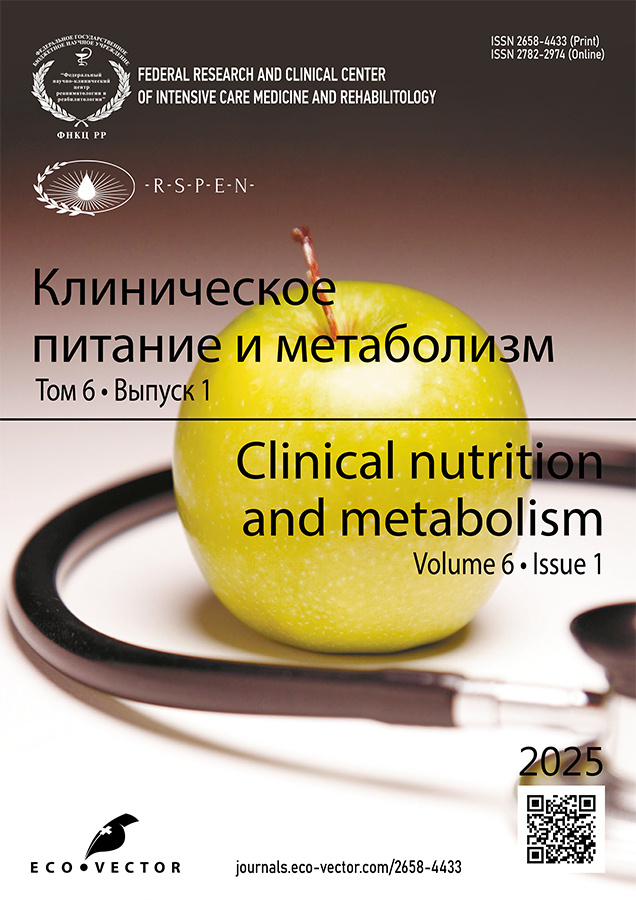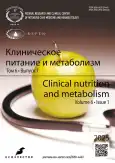Clinical nutrition and metabolism
Peer-review quarterly medical journal.
Editor-in-chief
- Prof. Sergey V. Sviridov, MD, Dr. Sci. (Med.)
ORCID: 0000-0002-9976-8903
Association
- Published under the supervision of National Association Organizations of Clinical Nutrition and Metabolism (RSPEN)
https://russpen.ru/
Journal founders
- Federal Research and Clinical Center of Intensive Care Medicine and Rehabilitology
- Eco-Vector Publishing Group
Publisher
- Eco-Vector
WEB: https://eco-vector.com/
About
The purpose of this peer-review academic medical journal is to publish up-to-date information on modern approaches to nutritional support for various conditions and diseases.
The target audience of the journal is specialists in the field of anesthesiology & resuscitation, pulmonology, surgery, oncology, neurology, gastroenterology, dietetics, pediatrics, therapy, as well as general practitioners.
Types of accepted articles
- reviews
- systematic reviews and metaanalyses
- original research
- clinical case reports and series
- letters to the editor
- short communications
- clinial practice guidelines
Publications
- in English and Russian
- quarterly, 4 issues per year
- continuously in Online First
- with NO Article Processing Charges (APC)
- distribution in Open Access, under the Creative Commons Attribution 4.0 International License (CC BY 4.0)
Indexation
- RUS White list
- Russian Science Citation Index
- Russian Science Electronic Library (eLibrary.ru)
- Google Scholar
- Ulrich's Periodicals directory
- Dimensions
- Crossref
Current Issue
Vol 6, No 1 (2025)
- Year: 2025
- Published: 24.10.2025
- Articles: 5
- URL: https://journals.eco-vector.com/2658-4433/issue/view/13658
- DOI: https://doi.org/10.17816/clinutr.61
Full Issue
Reviews
Nutritional support in chronic pancreatitis: a review
Abstract
Nutritional deficiency in chronic pancreatitis is a complex, multifactorial problem associated with malabsorption, pain, severe metabolic disturbances, and comorbid conditions. The most common cause of chronic pancreatitis is alcohol consumption. Timely diagnosis based on medical history, physical examination, and laboratory and instrumental findings helps prevent the development of severe protein–energy malnutrition. Before initiating nutritional support, it is essential to identify the individual causes of weight loss. The goal of nutritional support is to correct malnutrition and address the underlying causes of impaired digestion and absorption. It prevents further progression of protein–energy deficiency. Nutritional status should be assessed using clinical evaluation, functional tests, anthropometric measurements, and biochemical parameters. Body mass index alone does not adequately reflect the presence of sarcopenia in patients with obesity and chronic pancreatitis. Prevention and correction of nutritional deficiency require pancreatic enzyme replacement therapy, adequate caloric intake, and sufficient protein and micronutrient supply. If nutritional needs cannot be met through a regular diet, nutritional support should be initiated. Enteral nutrition is the preferred method. Parenteral nutrition is indicated in patients with gastric outlet obstruction, fistula formation, or intolerance to enteral feeding. This approach helps prevent malnutrition and sarcopenia and improves quality of life.
 5-13
5-13


Optimization of protein intake in adults with catabolic conditions: a review
Abstract
Protein is one of the key macronutrients. Therefore, the development of protein deficiency adversely affects health status and treatment outcomes. At the same time, protein requirements vary considerably among different patient populations. Optimization of protein intake in at-risk groups remains an important issue, as it may influence the effectiveness of specialized treatment, quality of life, and social functioning of patients. The aim of this review was to examine approaches to correcting protein deficiency in the most vulnerable adult populations, including older and elderly individuals, oncology patients, and critically ill patients. Publications indexed in the Scientific Electronic Library (eLibrary.ru) and PubMed databases between 2000 and 2025 were analyzed. The analysis demonstrated the need for an individualized approach to protein prescription. The review discusses current trends in nutritional support for these patient populations. In cases of inadequate protein intake, the use of high-protein enteral formulas as a supplement to the regular diet can positively affect treatment outcomes and quality of life. Whey protein currently attracts particular interest. Its use has demonstrated promising results, especially in combination with omega-3 fatty acids. Thus, an individually tailored protein component in nutritional support may improve treatment outcomes and quality of life in older adults, oncology patients, and critically ill patients.
 14-25
14-25


Original Study Articles
Effectiveness of second-stage rehabilitation in patients after radical surgery for gastric cancer: a pilot study
Abstract
BACKGROUND: Surgical intervention activates catabolic processes, which adversely affect treatment outcomes, increase the risk of complications, and prolong recovery. Implementation of a second-stage rehabilitation program promotes restoration of functional status; however, patients with concomitant nutritional disorders often tolerate such programs poorly.
AIM: The work aimed to evaluate the effect of a second-stage rehabilitation program—including moderate-intensity physical exercise combined with additional oral enteral nutrition enriched with protein and omega-3 fatty acids—on the functional and nutritional status of patients after radical surgery for gastric cancer (gastrectomy with D2 lymph node dissection).
METHODS: A prospective, observational, single-center study included 40 patients with gastric cancer (23 men and 17 women) aged 56–73 years. All patients had undergone radical surgery within 30 days before enrollment. The 14-day rehabilitation program consisted of supervised therapeutic exercise, independent training, correction of water–electrolyte imbalance, and supplemental enteral nutrition (Supportan Drink, 400 mL/day). Nutritional status, anthropometric parameters (weight loss over the previous 6 months and in the early postoperative period, body mass index, and mid-arm muscle circumference), physical endurance (6-minute walk test and handgrip strength), as well as anxiety and depression levels according to the Hospital Anxiety and Depression Scale (HADS), were assessed before and after completion of the rehabilitation program. Results are expressed as mean ± standard deviation. Differences were considered statistically significant at p ≤ 0.05.
RESULTS: Preoperative weight loss was 14.9% ± 9.03%, and postoperative weight loss before enrollment was 7.12% ± 2.28%. After completion of the rehabilitation program, mean mid-arm muscle circumference, handgrip strength, and 6-minute walk distance significantly increased: 24.38 ± 0.85 cm vs 26.77 ± 0.82 cm, 27.95 ± 2.1 kg vs 34.52 ± 2.2 kg, and 380.74 ± 15.26 m vs 437.18 ± 19.75 m, respectively (for all parameters, p < 0.05). Daily protein intake increased from 0.86 ± 0.19 g/kg to 1.39 ± 0.18 g/kg. Anxiety and depression scores significantly decreased from 11.35 ± 1.15 to 8.08 ± 1.12 points and from 12.5 ± 1.2 to 9.08 ± 1.1 points, respectively (p < 0.05).
CONCLUSION: Supplementation of the second-stage rehabilitation program (moderate-intensity physical exercise under the supervision of a therapeutic exercise instructor) with enteral nutrition enriched with protein and omega-3 fatty acids had a positive effect on the functional, psychological, and nutritional status of patients with gastric cancer after radical surgical treatment.
 26-34
26-34


Prognostic role of total protein concentration in hyperacute phase of ischemic stroke: results of secondary analysis of prospective study
Abstract
BACKGROUND: Stroke ranks second among causes of mortality worldwide. In Russia, 450,000–480,000 new cases are reported annually, often resulting in disability and cognitive impairment. Neurogenic dysphagia develops in 37%–78% of patients with ischemic stroke (IS). This condition, especially when combined with malnutrition—diagnosed in more than half of patients—significantly worsens the prognosis, complicates rehabilitation, and increases the risk of aspiration pneumonia and other infectious complications.
AIM: The work aimed to evaluate the prognostic value of total protein concentration in the hyperacute phase of ischemic stroke for clinical outcomes.
METHODS: Inclusion criteria were patients aged 18 years and older with primary IS confirmed by computed tomography or magnetic resonance imaging and the presence of dysphagia in the acute phase. Exclusion criteria included dysphagia of another etiology, pregnancy, malignant neoplasms, severe cardiovascular, hepatic, or renal disorders, and acute infections. Diagnosis was based on a comprehensive assessment including CT angiography, laboratory testing, electrocardiography, and echocardiography. Neurological status was assessed using the NIHSS (National Institutes of Health Stroke Scale), nutritional risk using the NRS-2002 (Nutritional Risk Screening), dysphagia severity using the MASA (Mann Assessment of Swallowing Ability), and treatment outcomes using the GOS (Glasgow Outcome Scale).
RESULTS: Mortality in the study group was 19.1%. ROC analysis demonstrated that the threshold value of total protein concentration on day 10 (59.3 g/L) was a significant predictor of mortality (AUC = 0.860; p < 0.001). For the atherothrombotic subtype of IS, the threshold protein concentration was 59.3 g/L (AUC = 0.887; p < 0.001), and 60.5 g/L (AUC = 0.771; p = 0.03) for the cardioembolic subtype. Both parameters demonstrated 100% sensitivity. A decrease in total protein concentration below these threshold values on day 10 was associated with increased mortality.
CONCLUSION: Secondary analysis of data from a prospective study evaluating the impact of protein–energy deficiency on treatment outcomes in IS complicated by neurogenic dysphagia revealed the prognostic significance of total protein concentration in the hyperacute phase of IS. These findings are particularly relevant for patients with the atherothrombotic subtype of IS. The obtained results may be applied in clinical practice; however, further randomized studies are needed to confirm these conclusions.
 35-42
35-42


Case reports
A case of using specialized medical nutrition product containing anhydrous betaine in patient with homocystinuria
Abstract
BACKGROUND: Although homocystinuria is a rare disorder, its management remains an important issue in modern pediatrics. Diet therapy is the main pathogenetic treatment for patients with homocystinuria. The use of betaine as part of combination therapy helps reduce plasma homocysteine concentrations, particularly in patients who do not respond to other treatment approaches.
A CASE REPORT: A 12-year-old child with genetically confirmed pyridoxine-responsive homocystinuria underwent substitution of an imported preparation containing anhydrous betaine with a specialized medical nutrition product, Amino Acid Module Betaine (ORPHANIC® trademark). The previously effective combination therapy regimen remained unchanged.
CONCLUSION: Replacement of anhydrous betaine within the previously established treatment regimen, followed by 30 days of administration of the medical nutrition product Amino Acid Module Betaine (ORPHANIC® trademark) containing betaine anhydrous, demonstrated a good safety profile. This substitution did not significantly affect the patient’s general condition, disease course, or key parameters of sulfur-containing amino acid metabolism.
Prescription of the medical nutrition product Amino Acid Module Betaine (ORPHANIC® trademark) containing anhydrous betaine, or transition of a patient to this product, requires monitoring of the patient’s general condition and regular determination of sulfur-containing amino acid metabolism parameters. This study represents the first clinical evaluation of anhydrous betaine produced in Russia. The obtained results indicate its efficacy and safety in the treatment of a patient with homocystinuria.
 43-50
43-50















